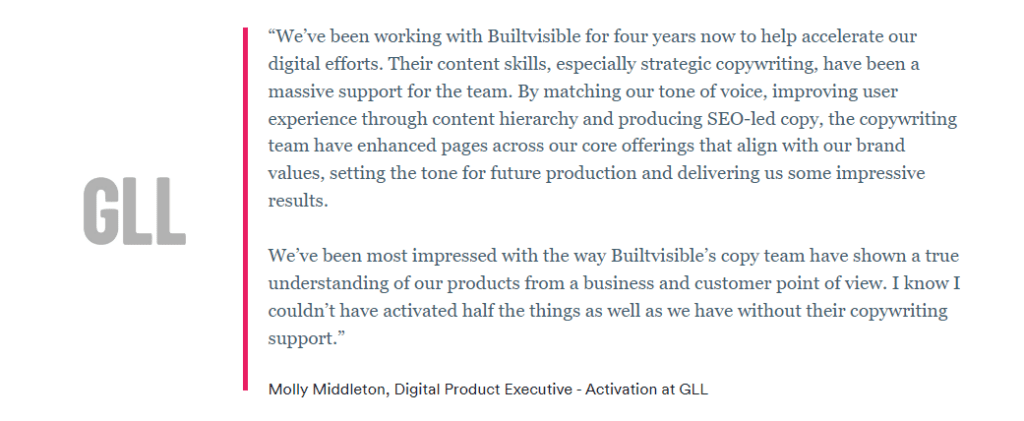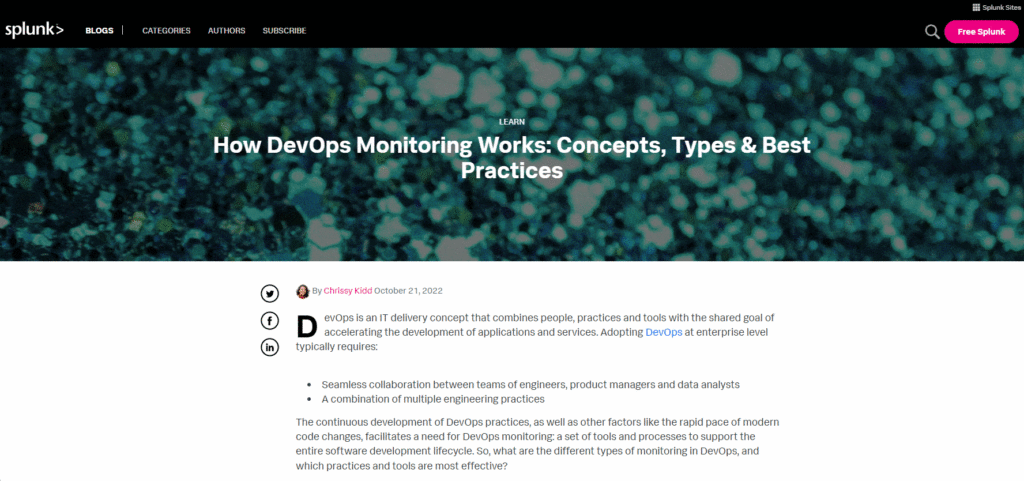Effective b2b content marketing
B2b copywriting is an essential cog in your marketing machine. Strong b2b copy is crucial because using it across all of your marketing channels allows you to nurture and drive leads and, ultimately, aid conversion.
So what exactly makes for successful b2b copywriting?
Firstly, an in-depth understanding of your audience.
Gaining a deep understanding of your audience and who you’re writing for is key to any form of content writing, really, but is particularly important for b2b writing. Of course, you may not be able to target your entire customer base in every piece of content you produce, but it pays to target certain pieces of content to certain audiences and to ensure that what you are writing will solve their particular pain points or needs.
Remember, unlike with b2c copywriting, your audience is much more likely to act based on your value proposition because it contributes to their business and helps solve a problem for them, not just because they like you as a brand or like the look of your product.
What else can you do to ensure effective b2b copy?
Writing clearly and succinctly and keeping readability front of mind is key. B2b copy can be notoriously dry, so it’s important to keep your audience engaged and interested and ensure that any tricky topics or concepts are broken down in a clear and digestible fashion (but without dumbing your content down). As our blog around spicing up ‘boring’ b2b content suggests, just because your service or product may on the face of it, seem difficult to write about, for your audience, it might be a lifesaver! Putting yourself in their shoes can really help you to frame your copy in a way that best resonates with your audience.
If you’re looking for more guidance on how to make b2b content more engaging in general, don’t miss our blog on this topic. Here’s an example of how one of our clients use creative infographics, like this one, to break up their copy and make b2b content more digestible:

Top tips: how to improve B2B copywriting and set yourself up for conversion
Now, let’s think about how we should frame our b2b copy so that it delivers to both managers and decision-makers.
Tip 1: Emphasise how your product will positively impact the decision maker’s business
One of the most important things to consider when writing b2b copy for decision-makers is to ask yourself one question: ‘what is it they care about?’
Sure, the SEO or marketing manager may have gone to them with a convincing case as to why they need your product or service (which they should be able to ascertain from your content anyway), but what factors are likely to get that decision maker to sign on the dotted line?
Typically, decision-makers will be reading your content and evaluating your product, asking themselves:
- Will it save the business money? What’s the ROI vs. the cost?
- Will it enhance staff’s productivity levels?
- Will it save us time, or help us to make efficiencies?
- Will it free up resource, or fill a gap we don’t have?
Essentially, they’re looking to determine whether their team or business will truly value from your product, and if so, if the cost is worth it. So the obvious solution? Early on in your content, highlight exactly how your product or service will impact these things – and use examples and stats to back it up.
Tip 2: Think about content structure: get your core points out there early on
If there’s one thing we know about decision makers, it’s that often, they are time-poor. When being presented with your content, they may not have time to read through all the finer details, so it’s best to almost begin with a conclusion – or with the big ‘why’. That is to say, succinctly answering why a customer should invest in your product or service, referring to the benefits the decision maker cares about.
Present this early on and keep it clear, concise and direct. Use simple, impactful sentences, and always keep front of mind how your service or product will help the b2b marketer or decision maker solve a problem.
Be specific, too. Avoid making vague or generalised statements, for example, “Helping your business to save production time and money”. Any business could make this claim, and it’s not really telling us much. Instead, if you can, state exactly how much time and money your product or tool could save them, like this:
“Helping you cut production time by up to 5 days a month, at a cost of £XYZ”.

Tip 3: Leverage the power of social proof
Decision makers and managers alike care about delivering on quality, and part of this process likely means being able to use reputable, quality tools or services to get the job done more efficiently.
It’s important that you use your copy to demonstrate the reasons why YOU are the company to do just that. But there’s only so far your words can go. That’s why it’s important to leverage the power of social proof. Proof that other like-minded businesses have come to rely on you before, and have been happy with your services; proof that you’re going to deliver.
Social proof can come in a number of different formats, including:
- Industry expert commentary
- Customer reviews or testimonials
- Case studies
- Expert authorship
- Social media shares
- Leveraging celebrity or spokespeople endorsement
- Cold, hard data
Using social proof in your content will also work to enhance your content’s EAT (expertise, authority and trust) which has important implications for SEO, despite not being a direct ranking factor. EAT is all the more important for b2b content, particularly if your business or industry is considered to be a ‘YMYL’ (Your Money or Your Life) service.
Additionally, logic and reasoning (as opposed to emotion) are two of the biggest driving factors when it comes to decision-makers making a b2b purchasing decision, so it’ll serve you well to also incorporate research, data, and industry insights into your content.
Tip 4: Adapt your copy for different stages of the buyer journey…and different content mediums
Part of the success of any decent marketing strategy is down to being able to maximise your content’s reach and distribution through a multi-channel approach. Essentially, ensuring your content is seen by the right people, at the right time, through the right mediums. To do this, you’ll need to think about the different stages of the funnel and how your customers interact with your content at these different stages, as well as the types of content they consume during this lifecycle. This is what we call journey mapping. After all, a decision maker may not find out about your product at the conversion stage – you may need to lead them there through top-of-the-funnel content.
This type of content could be blogs, but it could also take the format of social media posts. Or, if they are familiar with your brand and service, you could capture them through remarketing via an email campaign.
Either way, your b2b copywriting needs to consider the individual content medium and the stage of the funnel and adapt to suit.
B2b buyers in the awareness stage will require convincing copy that reinforces the notion that your company has authority in the space. Additionally, this content should help the customer to evaluate you as a business better (and, therefore as a potential solution provider). Blogs, white papers, and downloadable assets make for effective content mediums at this stage.
At the consideration stage, you could use case studies to convince your buyers, while further down the funnel, your copy can be a little more assertive in its messaging, with conversion-focused content and strong CTAs coming into play here.
Which brands are nailing b2b copywriting for decision makers?
Here at Builtvisible, our work with the world-leading b2b software provider Splunk serves as a good example of copywriting done well. Not only is their content clear, concise, and readable, but both their awareness and conversion-stage content is able to effectively draw out the benefits of the service that both a manager and decision-maker would care about. Let’s look at an example.

This top-of-the-funnel educational piece on how DevOps monitoring works quickly defines what the term means before succinctly outlining typical use cases and how these can help to ‘define, track and measure KPIs across all aspects of DevOps’. The blog highlights benefits such as reducing system downtime, increasing security, helping to identify root causes and boosting business credibility, all of which are aspects a decision-maker is going to care about.
Meanwhile, the ‘best practices for DevOps monitoring’ section is likely to be really helpful for managers who actually need to use the tool to set up and implement DevOps monitoring.
The copy in this piece succeeds as it utilises clear language and sentence structure, specific H2s to answer key audience queries, and generally features high-quality content that successfully matches the intent of the page and helps the user. Fun infographics and handy links to other useful information and resources only add to the value of the piece.
Concluding thoughts
If there’s one thing you should take away from this blog, it’s that you need to know your audience well in order to write good b2b copy that resonates with them. Put yourself in their shoes and ask yourself what they’d care about or need to know when investigating your service, and adapt your copy to suit.
Emphasising key benefits aimed at key decision makers and ensuring your content is structured in a way that makes potential customers want to keep reading will help – as will considering the buyer journey and leveraging social proof where you can.
Keep readability and clarity front of mind with your copy, and don’t be afraid to use data and case studies to back up your claims, too.
We’ve helped plenty of b2b clients navigate the tricky task of creating good quality, search-friendly content. If you want to know more about how our strategic copy team works with our b2b clients on all things content and copywriting, feel free to get in touch and chat things through with one of our dedicated specialists.
